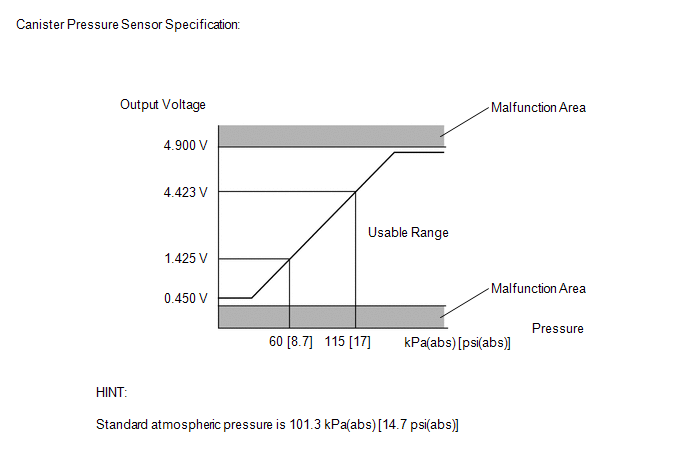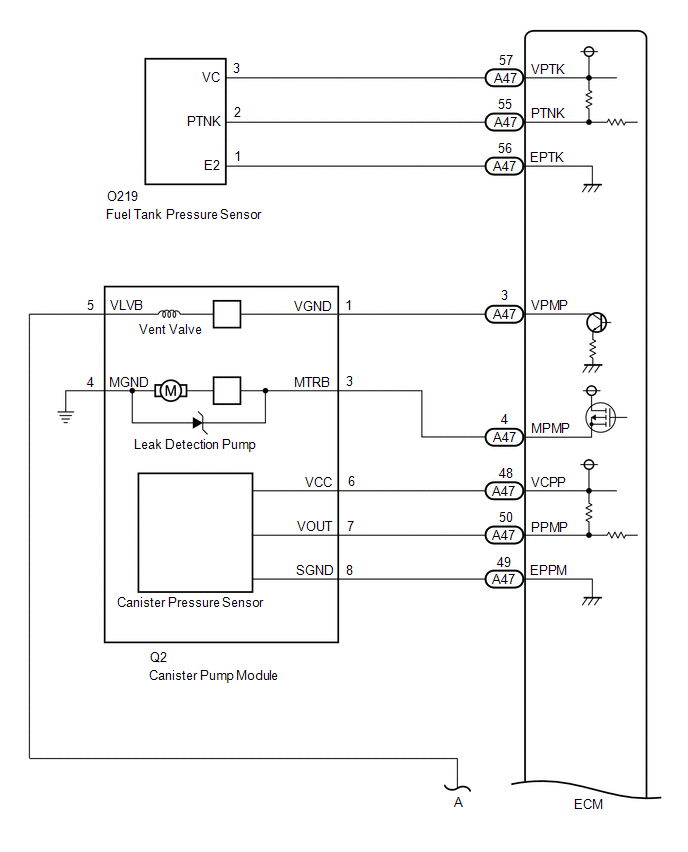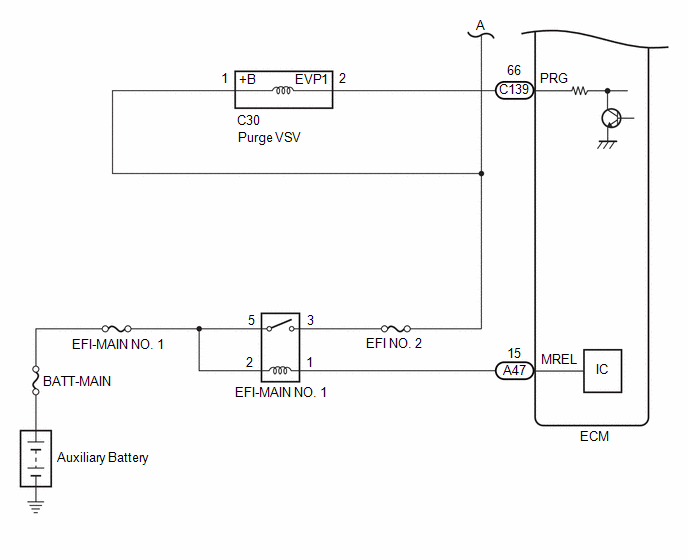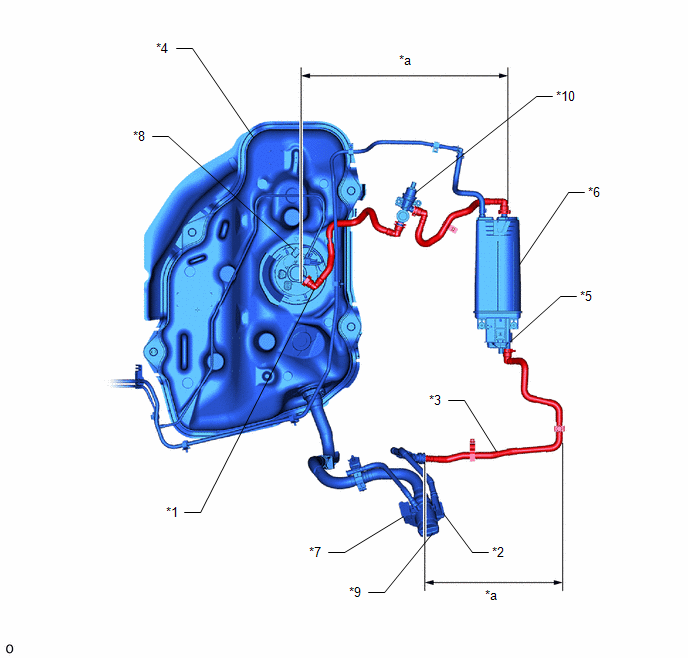Toyota Corolla Cross: Evaporative Emission System Pressure Sensor/Switch Circuit Short to Ground (P045011,P045015,P04502F)
DTC SUMMARY
|
DTC No. | Detection Item |
DTC Detection Condition | Trouble Area |
MIL | Note |
|---|---|---|---|---|---|
|
P045011 | Evaporative Emission System Pressure Sensor/Switch Circuit Short to Ground |
EVAP pressure is less than 42.110 kPa(abs) [6.106 psi(abs)] for 0.5 seconds or more. |
|
|
|
| P045015 |
Evaporative Emission System Pressure Sensor/Switch Circuit Short to Battery or Open |
EVAP pressure is higher than 123.761 kPa(abs) [17.945 psi(abs)] for 0.5 seconds or more. |
|
|
|
| P04502F |
Evaporative Emission System Pressure Sensor/Switch Signal Erratic |
Canister pressure sensor output voltage fluctuates frequently for a certain amount of time. |
| Comes on |
|
|
DTC No. | Monitoring Item |
Detection Timing | Detection Logic |
SAE Code |
|---|---|---|---|---|
| P045011 |
Canister pressure sensor low input |
| 1 trip |
P0452 |
| P045015 |
Canister pressure sensor high input |
| 1 trip |
P0453 |
| P04502F |
Canister pressure sensor abnormal voltage fluctuation (Noise monitor) |
| 2 trip |
P0451 |
HINT:
The canister pressure sensor is built into the canister pump module.
DESCRIPTION
Refer to EVAP (Evaporative Emission) System.
Click here
.gif)
MONITOR DESCRIPTION

- DTC P045011: Canister pressure sensor voltage low
If the canister pressure sensor output voltage (pressure) is less than 0.45 V: 42.110 kPa(abs) [6.106 psi(abs)], the ECM interprets this as an open or short circuit in the canister pressure sensor or its circuit, and stops the EVAP system monitor. If any deterioration has occurred, the ECM will illuminate the MIL and store this DTC (1 trip detection logic).
- DTC P045015: Canister pressure sensor voltage high
If the canister pressure sensor output voltage (pressure) is higher than 4.9 V: 123.761 kPa(abs) [17.945 psi(abs)], the ECM interprets this as an open or short circuit in the canister pressure sensor or its circuit, and stops the EVAP system monitor. If any deterioration has occurred, the ECM will illuminate the MIL and store this DTC (1 trip detection logic).
- DTC P04502F: Canister pressure sensor abnormal voltage fluctuation (Noise monitor)
If the canister pressure sensor output voltage fluctuates rapidly for 10 seconds, the ECM stops the EVAP system monitor. The ECM interprets this as the canister pressure sensor voltage fluctuating, and stops the EVAP system monitor. The ECM then illuminates the MIL and stores this DTC (2 trip detection logic).
MONITOR STRATEGY
|
Required Sensors/Components (Main) | Canister pump module |
|
Required Sensors/Components (Related) |
- |
| Frequency of Operation |
Continuous |
| Duration |
0.5 seconds: P0452 and P0453 Less than 15 seconds: P0451 |
|
MIL Operation | Immediate: P0452 and P0453 2 driving cycles: P0451 |
| Sequence of Operation |
None |
TYPICAL ENABLING CONDITIONS
P0451|
Atmospheric pressure | 70 kPa(abs) [10.2 psi(abs)] or higher, and less than 110 kPa(abs) [16 psi(abs)] |
|
Auxiliary battery voltage | 10.5 V or higher |
|
Intake air temperature | 4.4°C (39.9°F) or higher, and less than 50°C (122°F) |
|
Canister pressure sensor malfunction (P0452, P0453) |
Not detected |
| Either of the following conditions is met |
A or B |
| A. Ignition switch |
On (READY) |
| B. Time after key-off |
5, 7 or 9.5 hours |
|
Monitor runs whenever the following DTCs are not stored |
None |
| Both of the following conditions are met |
- |
| Either of the following conditions is met |
(a) or (b) |
| (a) Ignition switch |
ON |
| (b) Soak timer |
On |
| Auxiliary battery voltage |
8 V or higher |
TYPICAL MALFUNCTION THRESHOLDS
P0451: Canister Pressure Sensor Noise Monitoring|
Frequency that EVAP pressure change 0.3 kPa [0.04 psi] or higher |
10 times or more in 10 seconds |
|
EVAP system pressure sensor voltage (EVAP pressure) |
Less than 0.45 V [Less than 42.110 kPa(abs) (6.106 psi(abs))] |
|
EVAP system pressure sensor voltage (EVAP pressure) |
Higher than 4.9 V [Higher than 123.761 kPa(abs) (17.945 psi(abs))] |
CONFIRMATION DRIVING PATTERN
NOTICE:
- The Evaporative System Check (Automatic Mode) consists of 9 steps performed automatically by the GTS. It takes a maximum of approximately 40 minutes.
- Do not perform the Evaporative System Check when the fuel tank is more than 90% full because the cut-off valve may be closed, making the fuel tank leak check unavailable.
- Do not start the engine during this operation.
- When the temperature of the fuel is 35°C (95°F) or higher, a large amount of vapor will form and any check result will be inaccurate. When performing the Evaporative System Check, keep the fuel temperature less than 35°C (95°F).
HINT:
- After repair has been completed, clear the DTC and then check that the vehicle has returned to normal by performing the following All Readiness check procedure.
Click here
.gif)
- When clearing the permanent DTCs, refer to the "CLEAR PERMANENT DTC" procedure.
Click here
.gif)
- Connect the GTS to the DLC3.
- Turn the ignition switch to ON.
- Turn the GTS on.
- Clear the DTCs (even if no DTCs are stored, perform the clear DTC procedure).
- Turn the ignition switch off and wait for at least 30 seconds.
- Turn the ignition switch to ON [A].
- Turn the GTS on.
- Enter the following menus: Powertrain / Engine / Data List / Intake Air Temperature.
- Check that the intake air temperature is between 4.4 and 50°C (39.9 and 122°F) [B].
- Enter the following menus: Powertrain / Engine / Utility / Evaporative System Check / Automatic Mode [C].
- After the Evaporative System Check is completed, check for All Readiness by entering the following menus: Powertrain / Engine / Utility / All Readiness.
- Input the DTC: P045011, P045015 or P04502F.
- Check the DTC judgment result.
GTS Display
Description
NORMAL
- DTC judgment completed
- System normal
ABNORMAL
- DTC judgment completed
- System abnormal
INCOMPLETE
- DTC judgment not completed
- Perform driving pattern after confirming DTC enabling conditions
HINT:
- If the judgment result is NORMAL, the system is normal.
- If the judgment result is ABNORMAL, the system is malfunctioning.
- [A] to [C]: Normal judgment procedure.
The normal judgment procedure is used to complete DTC judgment and also used when clearing permanent DTCs.
- When clearing the permanent DTCs, do not disconnect the cable from the auxiliary battery terminal or attempt to clear the DTCs during this procedure, as doing so will clear the universal trip and normal judgment histories.
WIRING DIAGRAM


CAUTION / NOTICE / HINT
NOTICE:
- When a vehicle which has any of these DTCs stored is brought into the workshop, do not change the condition of the vehicle. For example, do not tighten the fuel tank cap assembly.
- The GTS is required to conduct the following diagnostic troubleshooting procedure.
- Vehicle Control History may be stored in the hybrid vehicle control ECU assembly if the engine is malfunctioning. Certain vehicle condition information is recorded when Vehicle Control History is stored. Reading the vehicle conditions recorded in both the Freeze Frame Data and Vehicle Control History can be useful for troubleshooting.
Click here
.gif)
(Select Powertrain in Health Check and then check the time stamp data.)
Click here
.gif)
- If any "Engine Malfunction" Vehicle Control History item has been stored in the hybrid vehicle control ECU assembly, make sure to clear it. However, as all Vehicle Control History items are cleared simultaneously, if any Vehicle Control History items other than "Engine Malfunction" are stored, make sure to perform any troubleshooting for them before clearing Vehicle Control History.
Click here
Click here
.gif)
PROCEDURE
|
1. | CONFIRM DTC AND EVAP PRESSURE |
(a) Read the DTCs.
Powertrain > Engine > Trouble Codes(b) Enter the following menus.
Powertrain > Engine > Data List|
Tester Display |
|---|
| Vapor Pressure Pump |
(c) Read the EVAP (Evaporative Emission) pressure displayed on the GTS.
|
Display (DTC Output) | Test Result |
Suspected Trouble Area | Proceed to |
|---|---|---|---|
|
P045011 | Less than 42.110 kPa(abs) [6.106 psi(abs)] |
| A |
|
P045015 | Higher than 123.761 kPa(abs) [17.945 psi(abs)] |
| B |
|
P04502F | - |
Canister pressure sensor |
C |
| B |
.gif) | GO TO STEP 5 |
| C |
.gif) | GO TO STEP 6 |
|
| 2. |
CHECK HARNESS AND CONNECTOR (CANISTER PUMP MODULE - ECM) |
(a) Disconnect the ECM connector.
(b) Measure the resistance according to the value(s) in the table below.
|
Tester Connection | Condition |
Specified Condition | Suspected Trouble Area |
Proceed to |
|---|---|---|---|---|
|
A47-50 (PPMP) - Body ground |
Always | Below 10 Ω |
| A |
|
10 kΩ or higher |
| B |
| B |
.gif) | GO TO STEP 4 |
|
| 3. |
CHECK HARNESS AND CONNECTOR (CANISTER PUMP MODULE - ECM) |
(a) Disconnect the canister pump module connector.
(b) Disconnect the ECM connector.
(c) Measure the resistance according to the value(s) in the table below.
|
Tester Connection | Condition |
Specified Condition | Suspected Trouble Area |
Proceed to |
|---|---|---|---|---|
|
A47-50 (PPMP) - Body ground |
Always | 10 kΩ or higher |
Short in canister pressure sensor circuit |
A |
| Below 10 Ω |
Short in wire harness/connector (canister pressure sensor - ECM) |
B |
| A |
.gif) | GO TO STEP 6 |
| B |
.gif) | GO TO STEP 7 |
| 4. |
REPLACE ECM |
(a) Replace the ECM.
Click here .gif)
| NEXT | .gif) | GO TO STEP 8 |
| 5. |
CHECK HARNESS AND CONNECTOR (CANISTER PUMP MODULE - ECM) |
(a) Disconnect the canister pump module connector.

|
*a | Front view of wire harness connector (to Canister Pump Module) |
- | - |
(b) Measure the resistance according to the value(s) in the table below.
Standard Resistance:
|
Tester Connection | Condition |
Specified Condition |
|---|---|---|
|
Q2-8 (SGND) - Body ground |
Always | 100 Ω or less |
(c) Turn the ignition switch to ON.
(d) Measure the voltage according to the value(s) in the table below.
Standard Voltage:
|
Tester Connection | Condition |
Specified Condition |
|---|---|---|
|
Q2-6 (VCC) - Body ground |
Ignition switch ON | 4.5 to 5.5 V |
|
Q2-7 (VOUT) - Body ground |
Ignition switch ON | 4.5 to 5.5 V |
| Test Result |
Suspected Trouble Area | Proceed to |
|---|---|---|
|
Voltage and resistance within standard ranges |
Open in canister pressure sensor circuit |
A |
| Voltage and/or resistance outside standard ranges |
Open in wire harness/connector (canister pressure sensor - ECM) |
B |
| B |
.gif) | GO TO STEP 7 |
|
| 6. |
REPLACE CANISTER PUMP MODULE |
(a) Replace the canister pump module.
Click here .gif)
NOTICE:
- When replacing the canister pump module, check the inside of the canister pump module and canister, and related pipes for water, fuel and other liquids. If liquids are present, check for disconnections and/or cracks in the following: 1) the pipe from the air inlet port to the canister pump module; 2) the canister filter; and 3) the fuel tank vent hose. If liquids are present in the inside of the canister, replace the canister and canister pump module.
- Check for filter blockage in the canister. If the charcoal filter inside the canister is clogged, replace the canister and canister pump module.
- Check for filter blockage in the canister filter. If there is blockage in the canister filter, replace the canister filter.

|
*1 | Fuel Tank Vent Hose |
*2 | Air Inlet Port |
|
*3 | Vent Hose |
*4 | Fuel Tank |
|
*5 | Canister Pump Module
| *6 |
Canister |
| *7 |
Canister Filter | *8 |
Fuel Tank Pressure Sensor |
|
*9 | Fuel Tank Cap Assembly |
*10 | Fuel Vapor-containment Valve |
|
*a | Inspection Area (Check for disconnection and/or cracks) |
- | - |
| NEXT | .gif) | GO TO STEP 8 |
| 7. |
REPAIR OR REPLACE HARNESS OR CONNECTOR (CANISTER PUMP MODULE - ECM) |
|
| 8. |
CLEAR DTC |
(a) Clear the DTCs.
Powertrain > Engine > Clear DTCs(b) Turn the ignition switch off and wait for at least 30 seconds.
|
| 9. |
CHECK WHETHER DTC OUTPUT RECURS (AFTER REPAIR) |
(a) Perform the Evaporative System Check using the GTS, referring to the Confirmation Driving Pattern.
(b) Enter the following menus.
Powertrain > Engine > Utility|
Tester Display |
|---|
| All Readiness |
(c) Input the DTC: P045011, P045015 or P04502F.
(d) Check the DTC judgment result.
|
GTS Display | Description |
|---|---|
|
NORMAL |
|
| ABNORMAL |
|
| INCOMPLETE |
|
| NEXT | .gif) | END |

.gif)

